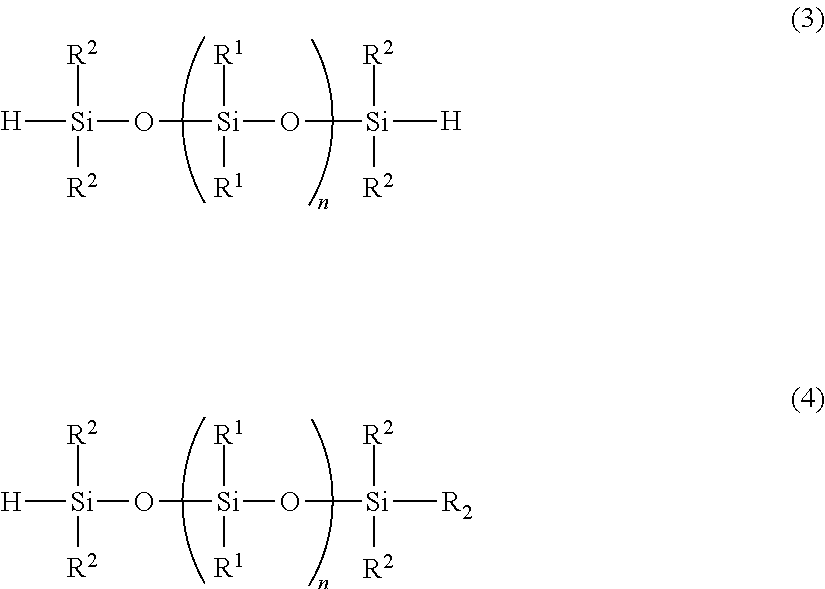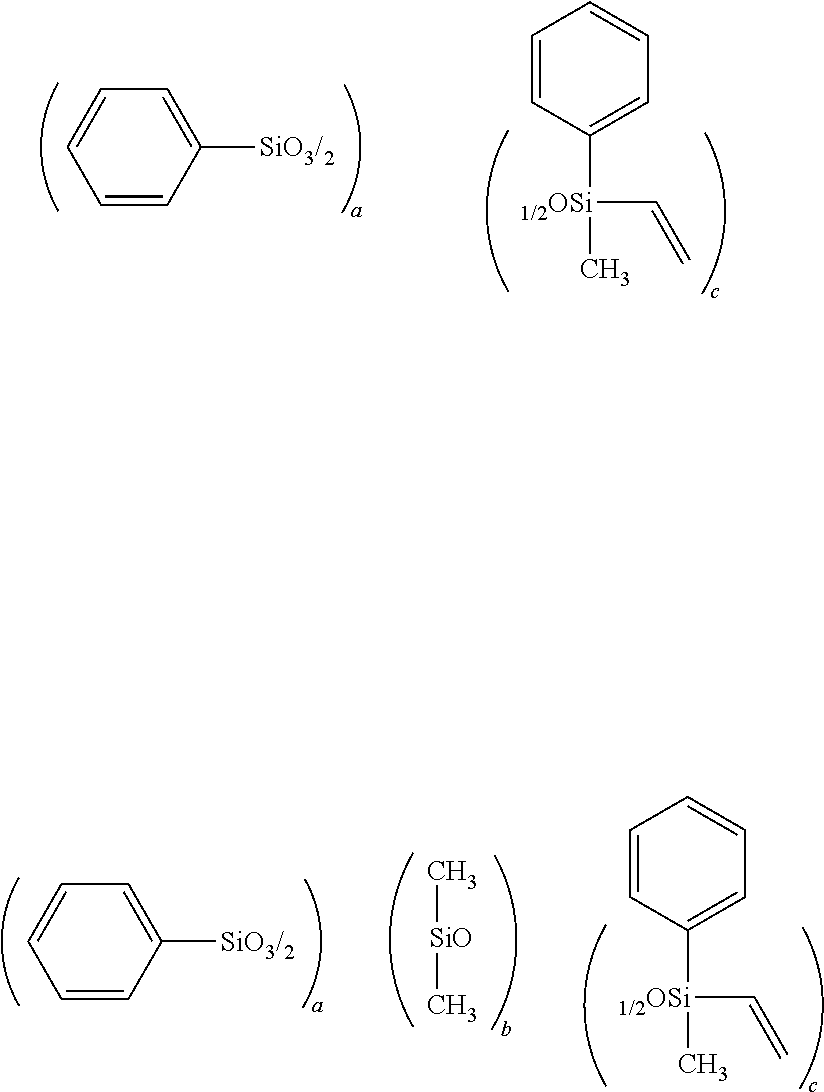Silicone resin composition and optical semiconductor device using the composition
a technology of silicon resin and composition, which is applied in the direction of other chemical processes, coatings, chemistry apparatuses and processes, etc., can solve the problems of unsatisfactory resistance to discoloration, reduced surface brightness of led, and blackening of lead frames, so as to reduce gas permeability, reduce the effect of gas permeability and dense structur
- Summary
- Abstract
- Description
- Claims
- Application Information
AI Technical Summary
Benefits of technology
Problems solved by technology
Method used
Image
Examples
synthesis example 1
Synthesis of Component (A)
[0097]A flask was charged with 1,000 g of xylene and 5,014 g of water, and a mixture containing 2,285 g (10.8 mol) of phenyltrichlorosilane, 326 g (2.70 mol) of vinyldimethylchlorosilane and 1,478 g of xylene was then added dropwise to the flask. Following completion of the dropwise addition, the resulting mixture was stirred for 3 hours, the waste acid was separated, and the remaining mixture was washed with water. Following subsequent azeotropic dehydration, 6 g (0.15 mol) of KOH was added to the flask, and the resulting mixture was refluxed overnight under heating at 150° C. The resulting mixture was neutralized with 27 g (0.25 mol) of trimethylchlorosilane and 24.5 g (0.25 mol) of potassium acetate, and following filtering, the solvent was removed by distillation under reduced pressure, completing synthesis of a siloxane resin having an average composition formula shown below. The weight-average molecular weight of the thus obtained siloxane resin, meas...
synthesis example 2
Synthesis of Component (A)
[0098]A flask was charged with 1,142 g of xylene and 4,629 g of water, and a mixture containing 1,480.5 g (7 mol) of phenyltrichlorosilane, 361.5 g (3 mol) of dimethylvinylchlorosilane and 1,712 g of xylene was then added dropwise to the flask. Following completion of the dropwise addition, the resulting mixture was stirred for 3 hours, the waste acid was separated, and the remaining mixture was washed with water. Following subsequent azeotropic dehydration, 20.64 g (0.184 mol) of a 50% by mass aqueous solution of KOH was added to the flask, and the resulting mixture was refluxed overnight under heat at an internal temperature of 150° C. The resulting mixture was neutralized with 34.0 g (0.313 mol) of trimethylchlorosilane and 30.7 g (0.313 mol) of potassium acetate, and following filtering, the solvent was removed by distillation under reduced pressure, the product was washed with methanol, and any residual methanol was removed by distillation under reduce...
synthesis example 3
Synthesis of Component (B-1)
[0099]A flask was charged with 5,376 g (22.0 mol) of diphenyldimethoxysilane and 151.8 g of acetonitrile, the solution was cooled to 10° C. or lower, and the dropwise reactions described below were performed at an internal temperature of 10° C. or lower. Namely, 303.69 g of concentrated sulfuric acid was added dropwise to the flask, 940.36 g of water was then added dropwise over a period of one hour, 2,216 g (16.5 mol) of (HSiMe2)2O was subsequently added dropwise, and the resulting mixture was then stirred overnight. Subsequently, the waste acid was separated, and following washing of the reaming mixture with water, the solvent was removed by distillation under reduced pressure, yielding an organohydrogenpolysiloxane 1 of the structure shown below. The amount of produced hydrogen gas was 90.32 ml / g (0.403 mol / 100 g). This organohydrogenpolysiloxane is termed “cross-linking agent 1”.
PUM
| Property | Measurement | Unit |
|---|---|---|
| Temperature | aaaaa | aaaaa |
| Length | aaaaa | aaaaa |
| Pressure | aaaaa | aaaaa |
Abstract
Description
Claims
Application Information
 Login to View More
Login to View More - R&D
- Intellectual Property
- Life Sciences
- Materials
- Tech Scout
- Unparalleled Data Quality
- Higher Quality Content
- 60% Fewer Hallucinations
Browse by: Latest US Patents, China's latest patents, Technical Efficacy Thesaurus, Application Domain, Technology Topic, Popular Technical Reports.
© 2025 PatSnap. All rights reserved.Legal|Privacy policy|Modern Slavery Act Transparency Statement|Sitemap|About US| Contact US: help@patsnap.com



